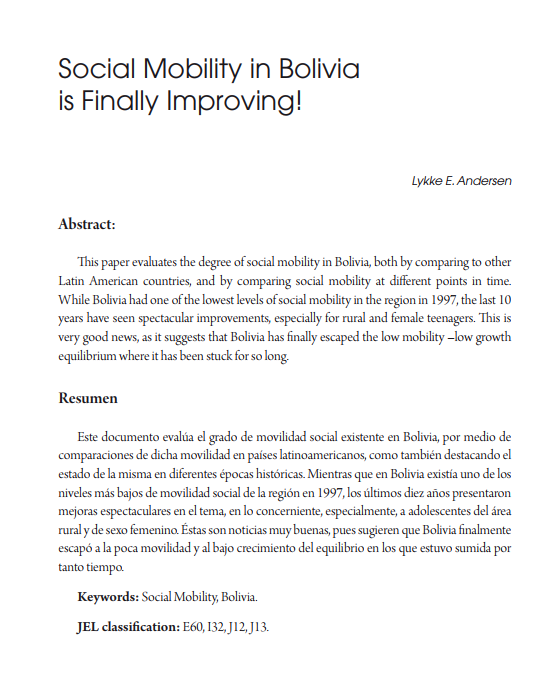Social Mobility in Bolivia is Finally Improving!
DOI:
https://doi.org/10.35319/lajed.201013157Keywords:
Bolivia, Social MobilityAbstract
This paper evaluates the degree of social mobility in Bolivia, both by comparing to other Latin American countries, and by comparing social mobility at different points in time. While Bolivia had one of the lowest levels of social mobility in the region in 1997, the last 10 years have seen spectacular improvements, especially for rural and female teenagers. This is very good news, as it suggests that Bolivia has finally escaped the low mobility –low growth equilibrium where it has been stuck for so long
Downloads
References
Alesina, A., & G.M. Angeletos. 2005. “Fairness and Redistribution”. American Economic Review, 95 (4): 960-980.
Andersen, L.E. 2001. “Social Mobility in Latin America”. Institute for Socio-Economic Research, Universidad Católica Boliviana. Working Paper No. 03/2000.
Andersen, L.E. 2003. “Social Mobility in Latin America: Links with Adolescent Schooling”. In: S. Duryea, A. Cox-Edwards & M. Ureta (eds.): Critical Decisions at a Critical Age: Adolescents and Young Adults in Latin America. Inter-American Development Bank. Chapter 6, pp. 219-247.
Azevedo, V. & C. P. Bouillon. 2009. “Social Mobility in Latin America: A Review of Existing Evidence”. Inter-American Development Bank, August 2009.
Baumol, W.J. 1990. “Entrepreneurship: Productive, Unproductive and Destructive”. Journal of Political Economy, Vol. 98(5): 893-921.
Behrman, J.R ., N. Birdsall &. M. Székely. 1998. “Intergenerational Schooling Mobility and Macro Conditions and Schooling Policies in Latin America”. Inter-American Development Bank, Office of the Chief Economist, Mimeo.
Bénabou, R ., & J. Tirole. 2006. “Belief in a Just World and Redistributive Politics”. Quarterly Journal of Economics, 121(2), 699-746.
Dahan, M. & A. Gaviria. 2001. “Sibling Correlations and Intergenerational Mobility in Latin America”. Economic Development and Cultural Change, 49(3): 537-54.
Ferreira, F. H. G. &. J. H. Gignoux. 2008. “The Measurement of Inequality of Opportunity: Theory and an application to Latin America”. World Bank Policy Research Work-ing Paper 4659.: World Bank.
Fields, G.S. 1996. “Accounting for Differences in Income Inequality” Draft, School of Industrial and Labor Relations, Cornell University, January.
Hassler, J. and J.V. Rodríguez-Mora. 1998. IQ, Social Mobility and Growth. Institute for International Economic Studies, Stockholm University, Seminar Papers No. 635, January.
Kremer, M. 1996. “How Much Does Sorting Increase Inequality?” NBER Working Paper No. 5566, May.
Mercado, A.F. & J.G.M. Leitón-Quiroga. 2009. “The Dynamics of Poverty in Bolivia”. Latin American Journal of Economic Development, 11: 45-82.
Mercado, A. F., L.E. Andersen, O. Nina &. M. Medinaceli. 2002. “Movilidad social: clave para el desarrollo”. Programa de Investigación Estratégica en Bolivia (PIEB) – Instituto de Investigaciones Socio-Económicas (IISEC), Universidad Católica Boliviana, La Paz.
Murphy, K.M., A. Scheifer and R.W. Vishny. 1991. “The Allocation of Talent: Implications for Growth”. Quarterly Journal of Economics, Vol. 106(2): 503-530.
Raut, L.K. 1996. “Signalling Equilibrium, Intergenerational Mobility and Long-Run Growth”. University of Hawaii-Manoa, Draft, February.
Roemer, J. E. 1998. Equality of Opportunity. Cambridge, MA: Harvard University Press.
Székely, M. & M. Hilgert. 1999. “What’s Behind the Inequality We Measure: An Investigation Using Latin American Data for the 1990s”. Research Department at the Inter-American Development Bank. Draft, December.
Transparency International. 2009. The Corruption Perception Index Information retrieved from http://www.transparency.org/policy_research/surveys_indices/cpi/2009/cpi_2009_table

Downloads
Published
How to Cite
Issue
Section
License
Copyright (c) 2010 Latin American Journal of Economic Development

This work is licensed under a Creative Commons Attribution-NonCommercial 4.0 International License.





